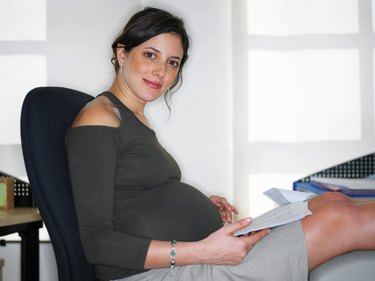
Rectal pressure during exercise can cause considerable discomfort and pain and can interfere with the type and duration of your workout. Feelings of pressure in the rectum may indicate a digestive problem or may result after childbirth or a pelvic injury. Fortunately, most cases of rectal pressure during exercise are preventable with dietary and lifestyle changes and are also treatable with medical care.
Features
Video of the Day
Rectal pressure during exercise can develop suddenly and feel like painful spasms, or it can come on slowly and feel like a weight is pushing down on the pelvis. The feeling of pressure may worsen with certain positions or activities, especially exercises that require sitting, such as biking or rowing. Depending on the cause of the rectal pressure, additional symptoms, such as rectal bleeding, passing mucus in the stool and constipation, can also occur. People with rectal pressure during exercise may also experience flatulence, bowel urgency or fecal incontinence.
Video of the Day
Causes
If you're pregnant or have just given birth, you may feel a sensation of rectal pressure during exercise, especially during your third trimester or when doing exercises while sitting or lying on your back. Hemorrhoids can also cause a feeling of rectal pressure during exercise along with symptoms such as bleeding from the anus and difficulty passing stool, explains the Merck Manuals Online Medical Library. Rectal ulcers may also cause rectal pressure and pain during exercise. According to the American College of Gastroenterology, less common causes of rectal pressure include anal abscess, fissure or fistula, arthritis of the coccyx, spinal or pelvic tumors or endometriosis.
Treatments
You can treat most cases of hemorrhoids that cause rectal pressure during exercise at home by taking sitz baths or using a stool softener. Pregnant and postpartum women may also benefit from sitz baths for treating rectal pressure. Large hemorrhoids may require rubber band ligation to cut off the blood supply and shrink them; other medical treatments for large hemorrhoids include laser destruction, infrared photocoagulation and electrocoagulation. Conditions such as rectal abscess, ulcers, fissures, fistulas and tumors of the spine or pelvis require surgical treatment.
Prevention
Eat a diet rich in fiber and drink plenty of water to help prevent rectal pain during exercise that results from hemorrhoids. If you're not used to a high-fiber diet, slowly increase your daily intake over time to prevent digestive discomfort due to dietary changes. In addition, continue to exercise for at least 30 minutes most days of each week to prevent rectal pressure by lessening the risk of constipation.